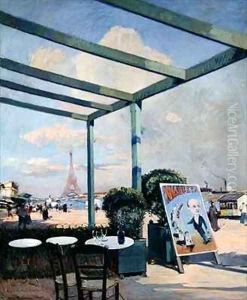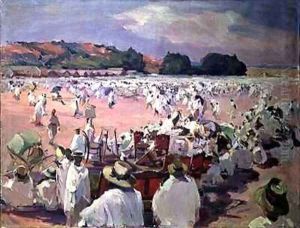Louis Jules Dumoulin Paintings
Louis Jules Dumoulin was a distinguished French painter, born in Paris in 1860. He is best known for his expertise in Orientalist subjects, capturing the essence of the Far East with a unique blend of accuracy and artistic flair. Dumoulin's fascination with Asian cultures was ignited by the global expositions of the late 19th century, which showcased the arts and crafts of the East to European audiences. His career took a pivotal turn when he embarked on extensive travels throughout Asia, including Japan, China, and India, where he diligently studied the landscapes, peoples, and traditions that would later populate his canvases.
Dumoulin's artistic journey began with his education at the École des Beaux-Arts in Paris, where he honed his skills under the tutelage of notable masters such as Jean-Léon Gérôme, a leading figure in French academic painting with a penchant for Orientalist themes. This training laid the foundation for Dumoulin's meticulous approach to detail and composition, as well as his adeptness at capturing the interplay of light and color. After completing his studies, Dumoulin initially made a name for himself as a marine painter, a genre through which he explored the dynamic and varying moods of the sea.
However, it was his Orientalist paintings that garnered Dumoulin significant acclaim. His works were celebrated for their vibrant colors, intricate details, and the sense of authenticity he brought to each scene. Dumoulin's paintings were not mere exotic fantasies; rather, they were informed by his firsthand observations and an earnest attempt to convey the cultural richness of the lands he visited. He exhibited his work at the Paris Salon and other prominent venues, earning medals and accolades for his contributions to French art.
In addition to his paintings, Dumoulin was also involved in decorative projects and the creation of panoramic works, a form of large-scale painting that gained popularity in the 19th century for its immersive qualities. One of his most ambitious projects was the Panorama of Japan, displayed in Paris, which offered viewers a 360-degree view of Japanese landscapes and cityscapes, effectively transporting them to the heart of Japan.
Louis Jules Dumoulin's legacy is that of a bridge between the East and West, through which he shared the beauty and diversity of Asian cultures with the European audience of his time. His work remains a testament to the enriching exchange between different worlds, captured through the lens of an artist deeply respectful and enamored with the traditions and landscapes he portrayed. Dumoulin passed away in 1924, leaving behind a body of work that continues to captivate and educate on the splendor of the East.

